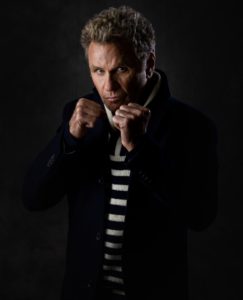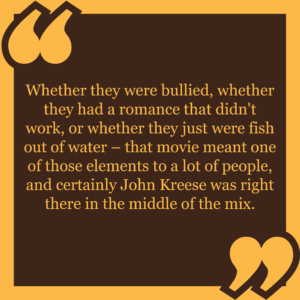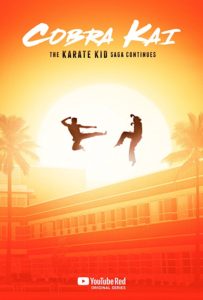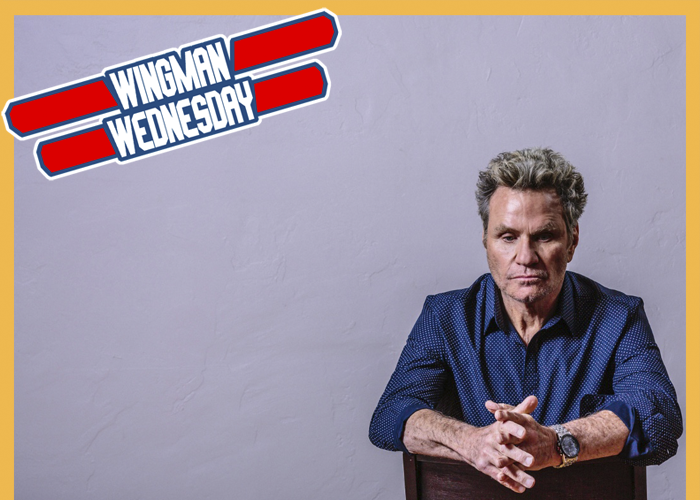
As bingers of pop culture, we’ve all been burned by the continuation of our favorite film franchises and series. The buzzy term “reimagnation” has become a bit of a dirty word, leaving many viewers skeptical of the projects that have come out of Hollywood in recent years. It’s the reason “The Karate Kid” faithful were leery of “Cobra Kai” when it was originally announced as a YouTube Red series, and it’s why so many who have already soaked up the show have been praising it as a love letter to them, the original fans. It hasn’t just met expectations, it has exceeded them.
Taking place 30 years after the events of the first movie, which made its debut in 1984, the 10-episode Season 1 reunites Johnny Lawrence (William Zabka) and Daniel LaRusso (Ralph Macchio) as their heated rivalry is rekindled upon Johnny reopening the Cobra Kai dojo. And when the original sensei, John Kreese, shows up, as a viewer you realize that this is a show that you never knew you wanted but now you absolutely need to have. (Editor’s Note: Please greenlight Season 2, YouTube!)
We recently sat down with THE Cobra Kai, Martin Kove, to discuss the character’s backstory, why he’s the Darth Vader of the karate world, and the prophetic dream he had just before he slipped back into the sensei’s skin.
TrunkSpace: Is it a bit of a surreal experience sitting down and talking about John Kreese 34 years after you first brought him to life?
Kove: Yeah. It’s a character that we’ve relived often, but not onscreen. It’s quite interesting. The people don’t forget it because the movie means so much to so many people. Back in ’84, they loved to hate John Kreese, so they love to respect him, or they love to love him, you know? The journey of that character is quite interesting because I wondered why the people loved such a beast, and he really wasn’t, per se, a beast. He was just someone who vowed never to lose again, which was a backstory that I personally created – that he was a champion forever. In high school, in college, in the armed forces, and when he went to the Vietnam War he wasn’t allowed to win like so many of our other boys, so many of our other soldiers. So, when he came back he swore when he opened up the dojo that his students would never lose, under any circumstances.
TrunkSpace: Without a backstory like that, he could have been a very one dimensional “bad guy.”
Kove: Yeah. It kind of went in that direction because you always create a backstory when you’re creating a character. A great luxury for doing a character that is basically non-fiction is that it’s a real life person and you can go research, which is my favorite – to go research someone, talk to the relatives and read papers, and there’s different scriptures of what that character’s done. The other end of the spectrum is you create it yourself, on the fictional character front like John Kreese. But John Kreese was a real life character in Robert Kamen’s world. He had a marine sergeant who was a disciplinarian like that. He based it on that. I said, “Was he worse than John Kreese?” Robert said, “He was far worse than John Kreese.” (Laughter) So, I could imagine that, you know?
TrunkSpace: Regardless of how bad Kreese gets in the films, the audience really loves to hate him. In many ways, he was a part of the childhood of so many impressionable viewers who absorbed that first movie in 1984. Like you said, it meant, and continues to mean, so much to people.
Kove: It really does. He’s the Darth Vader of the karate world, you know? It was really tricky. I remember when I got this series called “Hard Time on Planet Earth,” and at that time I remember my agent telling me, “Oh, I can get you out of the series. I can get you out of the series.” And I said, “If it’s going to conflict with ‘Karate Kid III’ then I don’t want to do it.” And he never could get me out of the series, and it was kind of a bittersweet experience. It was a series on CBS after I did “Cagney and Lacey.” It was heartbreaking because most of the people involved – John Avildsen and Jerry Weintraub who, bless their souls, have gone now – but I don’t think they ever believed me that I didn’t know that I could be in that show. So, the assistant director Cliff Coleman suggested, “We could make this work.” Because it was my vehicle and I was to do a sting operation against Ralph (Macchio) and also train Sean Kanan, the other bad boy. Ultimately John didn’t want to risk it, so I came in on the periphery of the movie and sent on vacation by the character Terry Silva. That character was written into the script because I couldn’t do it. I was supposed to, basically, do everything he did. As good a job as Terry did – Thomas Ian Griffin was his name – as good a job as he did as the associate of John Kreese, he still wasn’t John Kreese. You can’t disenfranchise the villain in these kinds of movies, because everybody’s looking for the same guy, because he’s meant so much in the initial outing of 1984. Whether they were bullied, whether they had a romance that didn’t work, or whether they just were fish out of water – that movie meant one of those elements to a lot of people, and certainly John Kreese was right there in the middle of the mix.
 TrunkSpace: You made a great comparison to Darth Vader. There have been plenty of movies in the “Star Wars” franchise now, and plenty of villains, but none of them have lived up to Vader.
TrunkSpace: You made a great comparison to Darth Vader. There have been plenty of movies in the “Star Wars” franchise now, and plenty of villains, but none of them have lived up to Vader.
Kove: No, they haven’t. And I like the movie very much – the last one – but I missed that ominous quality that James Earl Jones put to the voice, and that was put in the costume. You have to remember, to everybody, Sean Connery was the best James Bond. For the same reason, when we’re young we’re so impressionable, and these characters mean so much when they’re written well. Because to me, the bottom line is, with “The Karate Kid,” I don’t care what anybody says, and I used to have this argument with Robert Kamen all the time – the real star is Robert Kamen. He put pen to paper and did “wax on, wax off,” “sweep the leg” and “no mercy.” He did it, and without that, despite the charisma that he always says was the star of the movie, between Ralph and Pat (Morita), the real star for me has always been the written word.
TrunkSpace: You can be a cool character in a not-so-great movie, but that probably doesn’t carry the same weight personally when you’re working with a great script from start to finish?
Kove: Yes, exactly. Exactly. You can do five lines in a hit and… I had two scenes in “Wyatt Earp” and I remember chatting with Jackie Collins one day and she said, “You’re the funniest thing in the movie. He throws a cue ball in your throat and takes your rig and wears it for the rest of the movie. He feels his power after he knocks you out against the bar.” And I had a great time on that movie. I cried when I left the set. I mean, working with Kevin Costner was heaven. But, the bottom line is, two scenes in a good movie is far better than starring in a film that nobody goes to see.
TrunkSpace: Right, because it probably means more to you as a performer when something means so much to so many people.
Kove: Yeah, God knows how many times I’ve made a mistake in my career of being arrogant enough to think that my performance would make the movie better, and the script wasn’t up to par, but I would agree to go do a movie because I loved the character, and my arrogance would say, “Well, you’re doing a good performance, it’ll help the movie.” Bullshit. Doesn’t happen. Doesn’t happen. If it’s not on the page, forget it, and if you’re that arrogant then probably you should go back to class.
TrunkSpace: And then there are those instances where you might have the greatest script with the greatest cast being spearheaded by the greatest director and yet, for whatever reason, the universe just deems it not the time and it never finds an audience.
Kove: Oh, absolutely. Yeah. I think that kind of happened with a couple of wonderful movies that I still loved. That happened with “Goin’ South” with Jack Nicholson, Marlon Brando, Arthur Penn. You really figured, “Whoa, you got it, man.” You got the “Bonnie and Clyde” director, you got two big stars, and there’s something missed in that, you know? It’s just strange. It’s all strange. It’s just, when the elements come together, like this series… I didn’t know every episode would be written so well. I knew that Josh (Heald) and Hayden (Schlossberg) and Jon (Hurwitz) were wonderful. We sat around in September saying, “You’re going to come in in episode 10,” and I had to hold and bite my tongue for eight months with people asking me, and I’m telling them I’m dead, I’m telling them I’m the KGB, I’m telling them that I work for the CIA, that I’m in prison. I made up all these stories, you know? Because it was hard. And nobody believed me to be perfectly honest, nobody ever believed it. They said, “How could ‘Cobra Kai’ be a series without John Kreese?” I would say, “I don’t know.” (Laughter)
But these people pulled out the best elements, the very best elements of the movie, and put them in the series, and they wrote the dialog so well. Billy is brilliant, and Ralph is terrific. Billy and I have done a bunch of other movies together, but this by far is his best performance, and he touches all kinds of emotions here. Ralph does the same.
TrunkSpace: Even beyond being so well written, in many ways, it feels like a love letter to the fans.
Kove: Exactly. Very well put. It is a love letter to the fans. For these people this is their “Star Wars.” This is, if it was me and I was writing, would be my “Wild Bunch.”

TrunkSpace: As you mentioned, you come in at Episode 10, and while you didn’t get to really dive into the series during the first season, your appearance at the end was really cool and serves as both an exclamation point on the first season and a question mark for any second season to come.
Kove: That’s how they always expressed it to me. And I wanted to come in earlier and they said, “No, no, no. We’re going to have you come in at…” I had a bit of a dream about what that scene would be like. I dreamt a couple of weeks before, and I don’t remember telling it to Josh Heald, but it was similar. I was leaning against the window, and because I know what the dojo looks like now, it’s not far from my home – it’s divided into two stores, the dojo that was the Cobra Kai on Lankershim Boulevard in Los Angeles. I’ve driven past it. I had this vision of me leaning against the store front glass window, and then they both walk out and I’ve got a cigar and I’m saying, “Well, you’re doing well my heroes, but which one of you is the real hero?” And that’s what I had a vision of saying. In the scene they constructed I come into the dojo and it’s just Billy, but in essence it’s the same dialog. And I am smoking a cigar when I walk in. So, it’s kind of like God’s watching over me, you know?
TrunkSpace: You’re being fed lines beforehand from high above!
Kove: It’s fascinating!
Season 1 of “Cobra Kai” is available now on YouTube Red.


